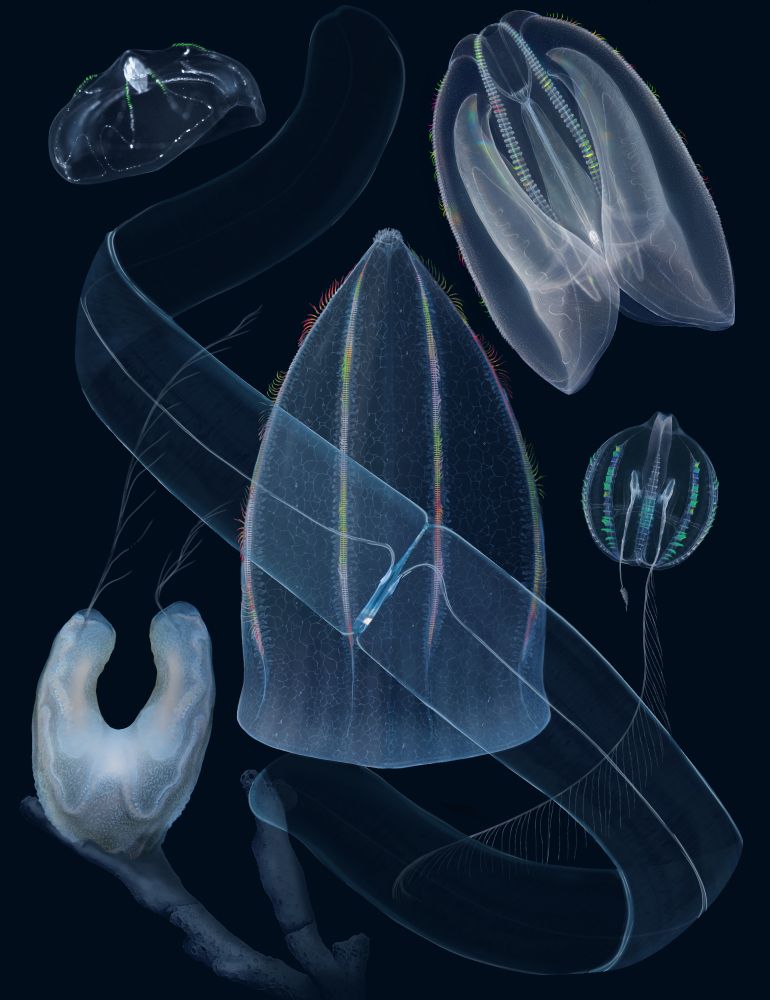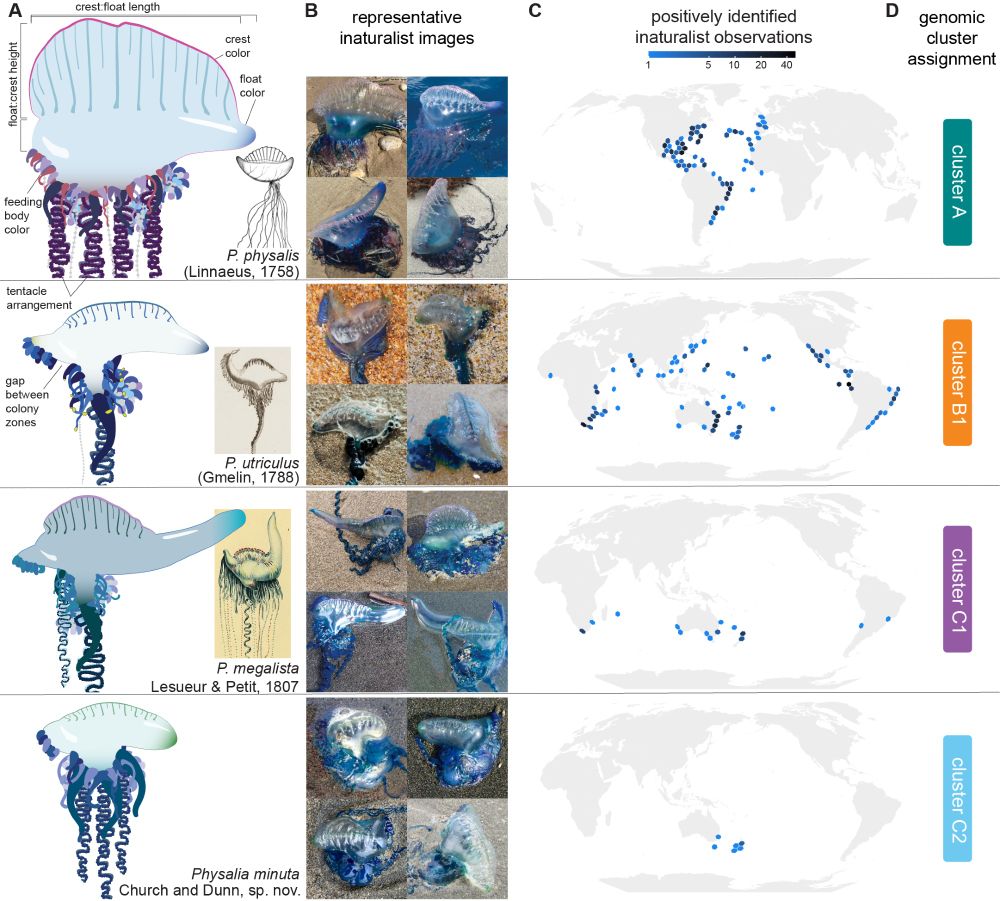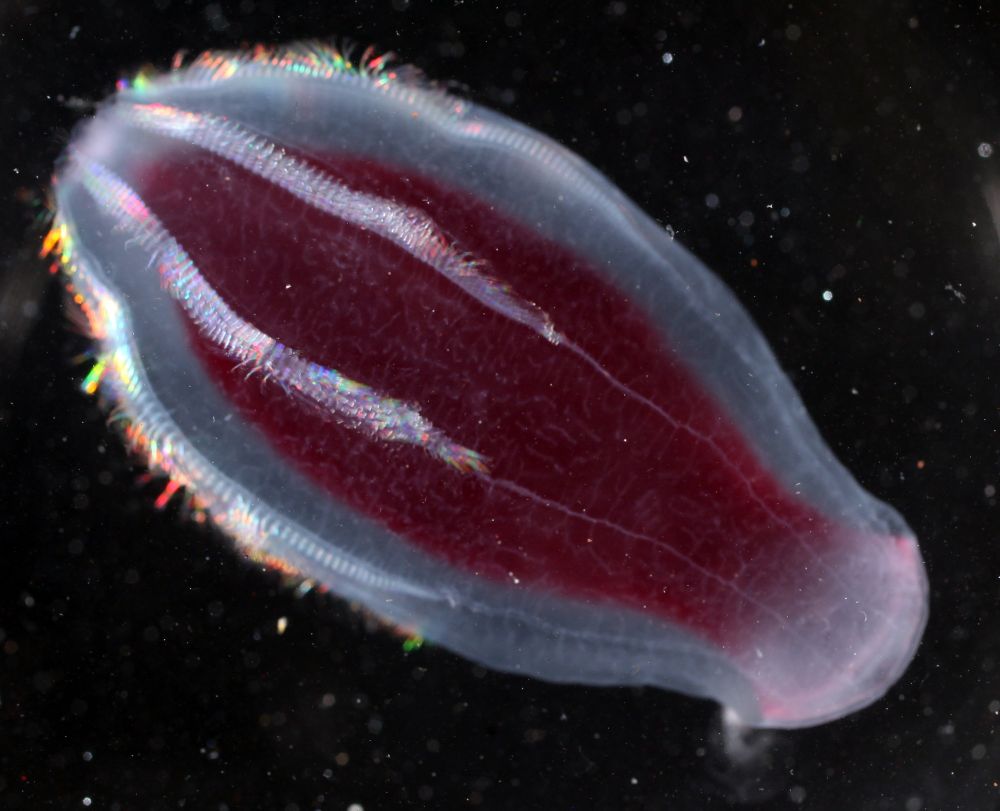
Some of our favorite covers over the course of the past 11 years have been ones that feature images that beautifully and accurately showcase emerging science.
We might be a bit biased 🫣, but we couldn't agree more @science.org
www.science.org/content/blog...
#ctenophores @msarscentre.bsky.social
27.10.2025 14:47 — 👍 18 🔁 2 💬 0 📌 0
Spooky season royalty 👑🎃✨️
Atolla gigantea is the largest Atolla species found off the West Coast. This deep-sea crown jelly can reach a diameter of up to 15 centimeters (six inches) and is one of the most widely distributed jellyfish. The genus occurs worldwide, from the Arctic to the Antarctic.
22.10.2025 16:55 — 👍 141 🔁 38 💬 1 📌 4
The redhead larvacean is a deep-sea climate hero 🌊💙
These tiny animals build mucous houses to filter marine snow sinking from the waters above. When their filters clog, they abandon their homes, which sink to the seafloor packed with nutrients and large amounts of carbon: youtu.be/7swiAc8rZbk?...
16.10.2025 20:33 — 👍 129 🔁 37 💬 3 📌 5

Drawing of various Ctenophore anatomies showing the diversity of the phylum. center/front, top left, and right are lobate ctenophores, center/back is a beroid or nuda ctenophore, center/right is a cydippid or tentacled ctenophore, and bottom/left is a benthic ctenophore

A drawing of the Blood belly comb jelly ctenophore (comb jelly) which is known for its stricking red coloration that helps it live in the deep sea
Happy Ctenophore day! Its a perfect day to celebrate such a small yet beautifully diverse phyla that comes in a wide array of shapes and colors. #Ctenophoreday
04.10.2025 13:38 — 👍 42 🔁 17 💬 3 📌 1

Happy Ctenophore Day!
These glowing ocean drifters look like jellyfish but aren’t! They’re comb jellies, shimmering creatures that light up the sea with rows of beating cilia 💙🌈
Which species can you identify? 👀 Most are raised in @pawelburkhardt.bsky.social lab
#CtenophoreDay #CombJelly #Ctenophore
04.10.2025 18:21 — 👍 1841 🔁 298 💬 45 📌 12
Not uncommon, but always beautiful; the ever flappy-flappy #pelagic #SeaButterfly #Pteropod, Corolla spectabilis. This one is feeding, as can be seen by the mucus net that it’s currently reeling in.
#corollaspectabilis #plankton #blackwater #blackwaterdiving #gug #chrisgug #gugunderwater #ocean
10.09.2025 14:06 — 👍 62 🔁 18 💬 1 📌 1
Our science photo book The Radiant Sea is out Sept 2nd!!
30 years of research, 10 years of "we should", and a year of collating pix and writing.
Sönke and I show (mostly for the first time) images of how organisms produce, use, and interact with light in the sea. #bioluminescence #fluorescence 🦑🧪🌊
28.08.2025 02:22 — 👍 209 🔁 69 💬 14 📌 8
Had time to finish another Aliens dive’s memory card from May 6&8, 2024.
1) #Phronima with behbehies in a fantastically-colored salp
2/3) #Siphonophore (don’t lick)
4) #Ctenophore
5) #Swordfish
6) #Polychaete worm
7) #Scaleworm
8) Ctenophore
9) #MantisShrimp
21.08.2025 16:17 — 👍 32 🔁 9 💬 1 📌 1

Marine biodiversity: Gone with the wind? Our dispatch out now in @currentbiology.bsky.social
New research shows that wind and currents act as invisible barriers, reshaping our view of ocean connectivity. 🌊🪼
authors.elsevier.com/a/1lYLj3QW8S...
@iramaegele.bsky.social @msarscentre.bsky.social
04.08.2025 16:38 — 👍 27 🔁 12 💬 1 📌 2
Deep-sea raspberry ❤️✨️
The raspberry jelly (Aeginura grimaldii) is part of a small group of jellies called the narcomedusae. Species in this group are are known for having a relatively small number of tentacles that are attached higher to the bell compared to other groups of jellies.
07.08.2025 22:35 — 👍 221 🔁 49 💬 6 📌 3
Ctenophores possess a unique aboral organ that acts as a multisensory center, controlling complex behaviors. We’ve now created a ctenophore model integrated with our 3D volume EM data. Puts it into perspective.
Check out our recent work here: www.biorxiv.org/content/10.1...
#ctenophores #volumeEM
07.08.2025 08:18 — 👍 73 🔁 23 💬 4 📌 2
Adding a little zest to your day with the lemon jelly—Aegina citrea. 🍋
The lemon jelly is different from other jellyfish because it has only four tentacles extending from its bell. Although jellies in the genus Aegina are relatively well known, they can evolve unusual forms or colors in deep water.
30.07.2025 21:57 — 👍 171 🔁 38 💬 3 📌 3

illustrations of four species of Physalia alongside original drawings and iNaturalist images. Maps of positively identified iNaturalist records show the distribution of each species.
My favorite outcome was validating species descriptions from 18th century scientists who illustrated animals on their voyages. Their descriptions were often rejected as implausible – we found that in many cases they were exactly right. Yet another reason why @biodivlibrary.bsky.social is so valuable
19.06.2025 19:51 — 👍 49 🔁 10 💬 3 📌 0

Portuguese Man o' War (Physalia physalis)
Portuguese Man o' War from Hamilton Parish, Bermuda on April 29, 2022 at 12:59 PM by Miguel A Mejias, PhD.. Native species to the island. Blown in with strong NW winds.
We combined sequencing data with thousands of participatory science images via @inaturalist.bsky.social, to connect genomic clusters to distinct morphologies. Credit to awesome undergraduates River Abedon and Diego Ramirez on this part! www.inaturalist.org/observations...
19.06.2025 19:51 — 👍 11 🔁 2 💬 1 📌 0

Physalia megalista, a cnidiran with a gas filled float, raised sail, and long blue tentacles hanging below. Image credit: Dalila Destanović
Excited to share our study on sailing siphonophores, AKA bluebottles or man-o'-war! 🌊 we received hundreds of samples from scientists around the world, part of a huge effort to sequence genomes and test for multiple species 🧬 out today in @currentbiology.bsky.social doi.org/10.1016/j.cu... 🦑🧪📌
19.06.2025 19:51 — 👍 171 🔁 50 💬 2 📌 6

Two pictures of a ctenophore in the genus Callianira, collected during blue-water scuba dives off the coast of Hawaii. The figure on the left is a rather poor photo, in an aboral view, against a black background.
The photo on the right is a lateral view on a white background. The ctenophore is shaped like an arrowhead, and in the white-background view you can see that it is covered with small reddish-brown speckles. Larger spots cover the body, and small spots are arranged in rows parallel to the base of each comb plate. One tentacle is extended showing the pink-pigmented tentilla.
I am used to photographing #ctenophores in darkfield, but under those conditions it is hard to see the pigment spots on this little (5mm) specimen.
Fun to see the patterns that show up when viewed against a white background. 🧪🦑🌊
11.06.2025 22:02 — 👍 56 🔁 20 💬 2 📌 3

A rare #Scina #Amphipod, who appears to have caught and is consuming a #ctenophore.
#amphipod #scina #hyperidean #crustacean #blackwater #blackwaterdiving #blackwaterphotography #gug #gugunderwater #chrisgug #underwater #scubadiving
06.06.2025 17:38 — 👍 16 🔁 5 💬 0 📌 0
Unsolicited listicle: My list of the most criminally underused/underappreciated phylogenetic comparative methods. Note, I am not involved in ANY of these methods; but I see them as things people are often asking of comparative data but have been surprised at how infrequently they have been cited.
21.05.2025 20:06 — 👍 147 🔁 68 💬 4 📌 0
Might be a Callianira
21.05.2025 15:21 — 👍 2 🔁 0 💬 0 📌 0
Up close and personal with the angler siphonophore (Erenna sirena). 🎣
This cunning predator dangles luminescent lures that mimic crimson crustaceans and attract unsuspecting fishes. When a curious lanternfish gets too close, the siphonophore’s tentacles deliver a powerful sting and snare a meal.
14.05.2025 22:10 — 👍 55 🔁 14 💬 0 📌 0
Meet Eryoneicus, a deep-sea lobster larva. This cutie was spotted at 1,196 meters (3,923 feet) in Monterey Bay. Scientists originally called them Eryoneicus thinking they were a new species, before realizing they were the larval form of deep-sea lobster-like crustaceans in the family Polychelidae.
08.05.2025 20:41 — 👍 106 🔁 20 💬 1 📌 4

Picture of Beroe abyssicola from the northern Gulf of Alaska. This species is not part of the study. It is just meant to represent Ctenophore (comb jellies).
Our latest collaborative paper, led by NMNH intern Annemarie Wood, reports on a new tool for understanding ctenophore and medusozoan diversity. "Anthozoan eDNA primer set characterizes Ctenophora and Medusozoa ..." Characterizing #MarineLife
www.frontiersin.org/journals/mar...
09.05.2025 13:04 — 👍 4 🔁 1 💬 1 📌 0
Turning screen time into ocean action 📱🌊
The collective efforts of @fathomverse.bsky.social players around the world are enhancing AI models that researchers rely upon to deepen our understanding of marine ecosystems. Join us today and become part of the mission to discover all life in our ocean!
04.04.2025 21:59 — 👍 62 🔁 12 💬 0 📌 0

Two divers hover below a boat in the open ocean 4 miles off the coast of Hawaii. Crissy Huffard from Colleen Durkin’s lab is “flying” plankton into the view of their special ISIIS camera.
It’s hard to beat field work in Hawaii with @cadurkin.bsky.social @lenaunderwater.bsky.social and others of the @mbarinews.bsky.social team..!
We are using blue-water scuba diving to study #ctenophores, siphonophores, radiolarians, and #bioluminescence.
🦑🌊🧪🤿
05.04.2025 00:28 — 👍 39 🔁 6 💬 1 📌 2

These faster swimmers also tend to be more efficient in their cost of transport, as assessed by comparing their swimming vs. resting respiration rates. This research was funded by @MooreFound and @USNavyResearch 3/3
28.03.2025 16:38 — 👍 0 🔁 0 💬 0 📌 0

Linear architectures and others able to tuck many propeller zooids under a constrained frontal area present faster swimming speeds than those with a 1:1 ratio in zooids:area /2
28.03.2025 16:38 — 👍 0 🔁 0 💬 0 📌 0

Our paper on the developmental ontology of salp colonial architecture made the cover of The Biological Bulletin! @BiolBulletin With my photo of a developing Pegea chain! @SutherlandLab https://www.journals.uchicago.edu/doi/10.1086/731540
31.05.2024 20:04 — 👍 10 🔁 3 💬 1 📌 0
The pre-print for the last paper (under review) from my postdoc at the @SutherlandLab is up! Salp colonies vary in swimming speed and energetic efficiency across species and colonial architectures. Streamlining of propellers in a multi-jet system is key! https://www.biorxiv.org/content/10.1101/20...
22.04.2024 22:17 — 👍 0 🔁 0 💬 0 📌 0
Evolution of neurons and nervous systems / choanoflagellates / sponges / ctenophores. Group leader at the Michael Sars Centre (University of Bergen). @msarscentre.bsky.social Webpage: https://www.uib.no/en/michaelsarscentre/114773/burkhardt-group
Nature photographer, amateur naturalist & arthropod enthusiast. Florida natives, here. Pics my own. Dead Name Walking. Man't. They/Them (she/her even, if you're not creepy about it)
IG: @apsciencebylyn
Discord: evelyndroid
Tumblr: apsciencebylyn
Combining more than 120 years of ocean research with the repeatedly ranked No. 1 U.S. institution in innovation, impact and sustainability.
Scientist @icmcsic.bsky.social #Barcelona: aquatic microbes, ecosystems, genomics, evolution, AI, bioinformatics & SciFi 🇪🇸🇦🇷 https://log-lab.barcelona
PhD student at Southampton, studying mesopelagic fish ecology. Occasional writer and amateur baker. Tweets about fish in superlatives. Opinions my own.
i like weird deep sea shit, particularly cephalopods. also metal, parasitic fungi, horror, etc.
he/him, ace, adhd (maybe autistic?)
opinions are mine and not my employer’s
Bioengineer in MBARI’s Bioinspiration Lab, Smithsonian’s NMNH, Caltech, National Geographic Explorer, former USA ice dancer. Dog + cat mom. Hater of inefficiency and waste. Views are my own. she/her
Dr of small crawly things that live on the ocean floor.
I study what they do, how they do it, and how they respond to disturbance, including climate change.
Marine Biologist, Ocean Optimist, Invert Advocate, "Worm Girl"
Opinions mine. She/her
PhD student at
@IMASUTAS
| marine plankton physiology| ocean alkalinity enhancement
The Marine Biological Laboratory (MBL), founded in 1888, is an international center for research & education in biology & ecology in Woods Hole, MA. An affiliate of the University of Chicago. www.mbl.edu
Senior Collections Manager, Polycharetes, at the Natural History Museum of Los Angeles. All polys, all the time. Worms are Wonderful. Warthogs are nice too. Invert macrophotography to spread the love. Carnivorous plant & book hoarder.
Marine scientist working on plankton ecology & biogeochemistry of the Southern Ocean. Based in Te Whanganui-a-Tara, Aotearoa/New Zealand, they/she 🏳️🌈
Pro underwater photographer and filmmaker. Ocean art gallery📍Lauderdale by the Sea, FL
PhD on cnidarian stem cells 🪸. Interested in how genetics and evolution shape all life forms.
Ctenophore breeder for @pawelburkhardt.bsky.social lab at @msarscentre.bsky.social
ଳ Jellyfish photographer 🪼📷
All 📷 made by: @alexandrejan.bsky.social (© Alexandre Jan)
Artist and microscopist. MFA art + technology, but work in a neuro lab by day. Insects, neurons, electron microscopy… follow me to see lots of plankton videos…
jessholz.com
https://www.dannastaaf.com/
Author, artist, speaker with a fondness for cephalopods. Books:
🦑 Monarchs of the Sea
👩🔬 The Lady and the Octopus
🐣 Nursery Earth
🐙 The Lives of Octopuses and Their Relatives
Newsletter: https://buttondown.com/dannastaaf
Assistant professor at UConn. Marine biology, parasitic copepod taxonomy and evolution, crustacean genomics
www.BernotLab.org
Official account of the Deep-Sea Biology Society | #DSBSoc
A society for student, academic and professional #DeepSea biologists. 🌊
🔗 dsbsoc.org
🔗 @dsbsoc-arts.bsky.social
I am an evolutionary and marine biologist interested in how new structures and functions originate during evolution. Eyes, vision; photophores, bioluminescence. Macroevolution. Phylogenetics. Molecular Evolution. Integrative and Comparative Biology.


























